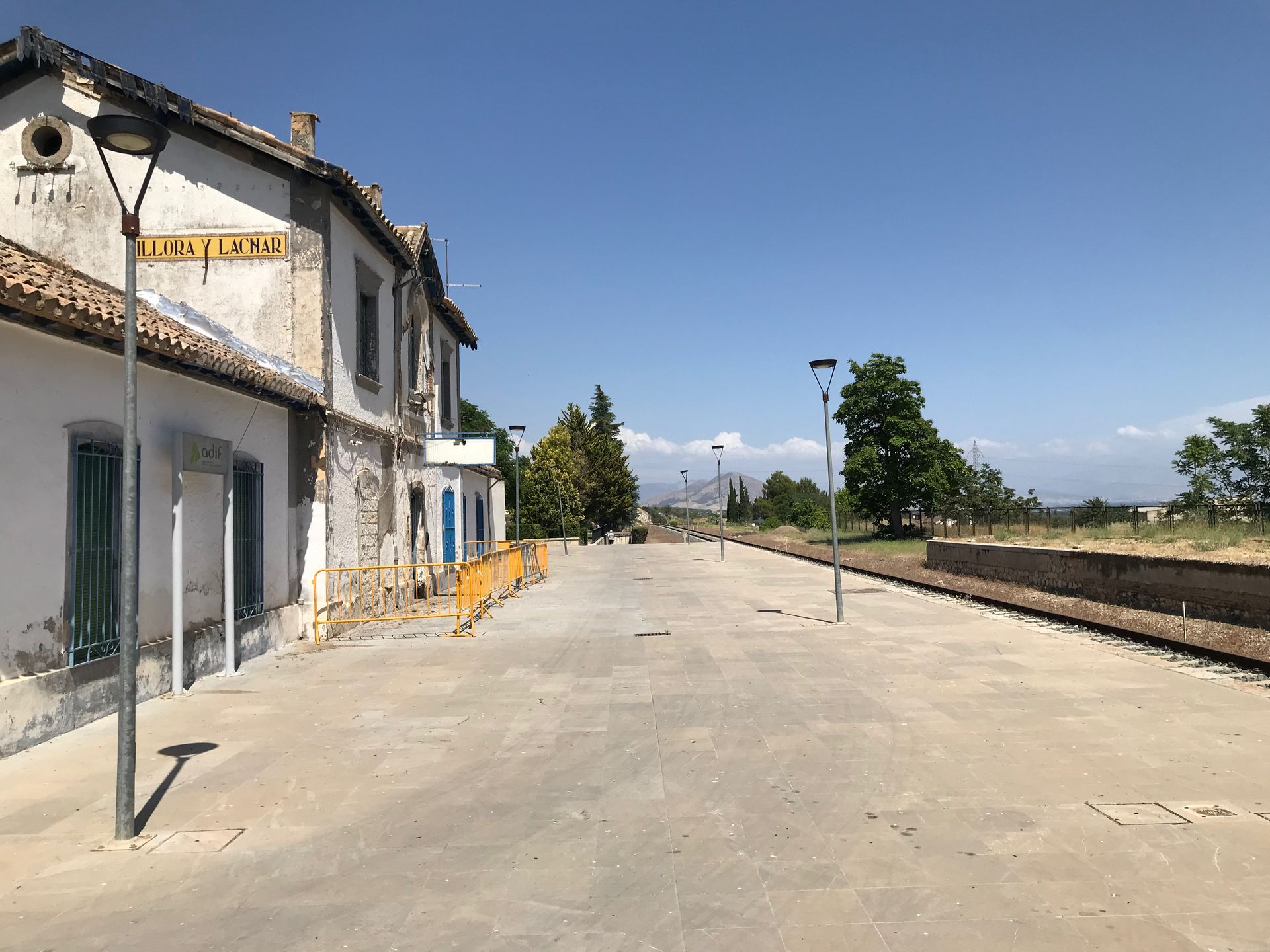Bif. Tocón – Bif. La Chana
CHARACTERISTICS
- OUT OF SERVICEInstalación logística de Pinos Puente (UTM 30S 432894 4122690); (P.K. 107,900)
- OUT OF SERVICEInstalación logística Atarfe-Santa Fe (UTM 30S 438264 4119163); (P.K. 114,200)
The line currently known as ‘464 – Bifurcación Tocón – Bifurcación La Chana’ was developed at the end of the 19th century as part of the line between Bobadilla and Granada, built with the aim of extending the railway connection between Córdoba and Málaga to the city of Granada.
The initial operating rights for the Bobadilla-Granada line were in private hands until 1863 when they were transferred to the Córdoba to Málaga Railway Company [‘1’] which quickly began construction work. In August 1865, the Bobadilla-Antequera section was completed, and in December 1866, the Loja-Granada section was finalised, where the Tocón Fork – La Chana Fork section is today. The complex topography of the area, which made construction work difficult and caused significant delays, meant that the Antequera-Archidona section was not completed until 1869. Finally, the Riofrío-Loja section was put into service in May 1874, marking the total completion of the line. [1] [2]

Apeadero de Illora-Lachar (Granada)
In 1877, management of the line was transferred to the Andalusian Railway Company (CFA), a change that allowed it to be connected to other lines that formed part of the company’s network, with Granada established as its destination and terminus. [3] [4]
In 1904 the Moreda-Granada railway line was inaugurated by the Southern Spanish Railway Company, providing Granada with a second railway link. The two lines were joined in 1907 by a branch line, which connected the Bobadilla-Granada line with the rest of eastern Andalusia.
[5]
The CFA’s economic problems led to the company being taken over by the state during the Second Republic, specifically in 1936, which entrusted the management of its lines to the Compañía Nacional de los Ferrocarriles del Oeste. Subsequently, in 1941, when the Iberian gauge national railway network as a whole was nationalised, it became part of RENFE. In the following decades, without any new investment in the infrastructure, transport was developed mainly for passengers on a regional scale, although there were also services connecting with the Meseta and the Levante.
In 1877, management of the line passed into the hands of the recently founded Andalusian Railway Company [...]
In 1994, with the aim of improving regional services between Seville and Granada, the line was extended to Fuente de Piedra station, where it connected with the Utrera-Fuente de Piedra line.
[6] That same year, the opening of the Córdoba-Antequera section of the Córdoba-Málaga high-speed line led to a complete railway transformation in the area around Bobadilla station. Antequera-Santa Ana station was built and a gauge changer was installed so that it could be used on Iberian gauge lines. From that moment on, the Fuente de Piedra-Granada line was used by long-distance rail services, specifically the Altaria, which connected Granada with Madrid-Atocha.

Apeadero de Sierra Elvira (Granada)
In 2005, with the extinction of RENFE, within the framework of Law 39/2003 on the Railway Sector, it came under the control of Adif like the rest of the RFIG of the State.
In 2015, the construction of the Antequera-Granada high-speed line closed the line, as the Riofrío-Tocón junction and La Chana-Granada junction sections were integrated into mixed gauge as part of the route of the new line. The rest of the sections, Riofrío-Fuente de Piedra Junction and Tocón-La Chana Junction, were maintained, becoming Adif lines 460 and 464, respectively. This reconfiguration led to the elimination of the Fuente de Piedra-Granada line from the RFIG by Adif in its 2019 Network Statement. [7]
Currently, both the Riofrío-Fuente de Piedra and the Tocón-La Chana junctions are closed to conventional traffic and in a state of temporary closure. [8] [9]
In 2005, with the extinction of RENFE, within the framework of Law 39/2003 on the Railway Sector, it came under the control of Adif like the rest of the RFIG of the State.
The possibility of tourism potential along the line, which runs between transport infrastructure and industrial and logistics facilities that are largely abandoned, is not appreciated. The two existing stations are far from the towns and have the same architectural form, but while the Tocón-Montefrío siding building is closed, the Atarfe-Santa Fe siding appears to be used as a dwelling in 2024.
Category C2.
A disused railway line in an abandoned or partially dismantled state.
Photographic report

Apartadero cargadero de Atarfe-Santa Fe (Granada)

Vista de la Línea 646 junto a la línea de AV Antequera - Granada

Apartadero de Tocón - Montefrío (Granada)

Vista del final de línea en la Bifurcación La Chana (Granada)
References
-
F. Wais, Historia de los ferrocarriles españoles. Editora Nacional, 1974.
-
J. G. Raya, «Cronología básical de ferrocarril español de vía ancha», IV Congreso Historia Ferroviaria: Málaga, septiembre de 2006 (Consejería de Obras Públicas y Transportes de la Junta de Andalucía), 2006. [En línea]. Ver referencia
-
M. A. L. Morell, La Casa Rothschild en España: (1812-1941). Marcial Pons Historia, 2005.
-
F. Comín, 150 años de historia de los ferrocarriles españoles. Grupo Anaya, 1998.
-
P. P. Quintana, «Depósitos y talleres en las estaciones andaluzas de vía ancha», IV Congreso Historia Ferroviaria: Málaga, septiembre de 2006 (Consejería de Obras Públicas y Transportes de la Junta de Andalucía), 2006. [En línea]. Ver referencia
-
R. R. Melero, «Historia de la política ferroviaria de la Junta de Andalucía (1980-2005)», IV Congreso Historia Ferroviaria: Málaga, septiembre de 2006 (Consejería de Obras Públicas y Transportes de la Junta de Andalucía), 2006 [En línea]. Ver referencia
-
Adif, «Actualización de Activos de la RFIG Titularidad de Adif». Declaración de la Red 2019.
-
Adif, «Actualización de Activos de la RFIG Titularidad de Adif». Declaración de la Red 2025.
-
J. J. Medina, «La falta de interés de los operadores de trenes pone en duda el futuro de la línea entre Granada y Bobadilla», Granada Hoy, 10-ago-2020. [En línea]. Ver referencia